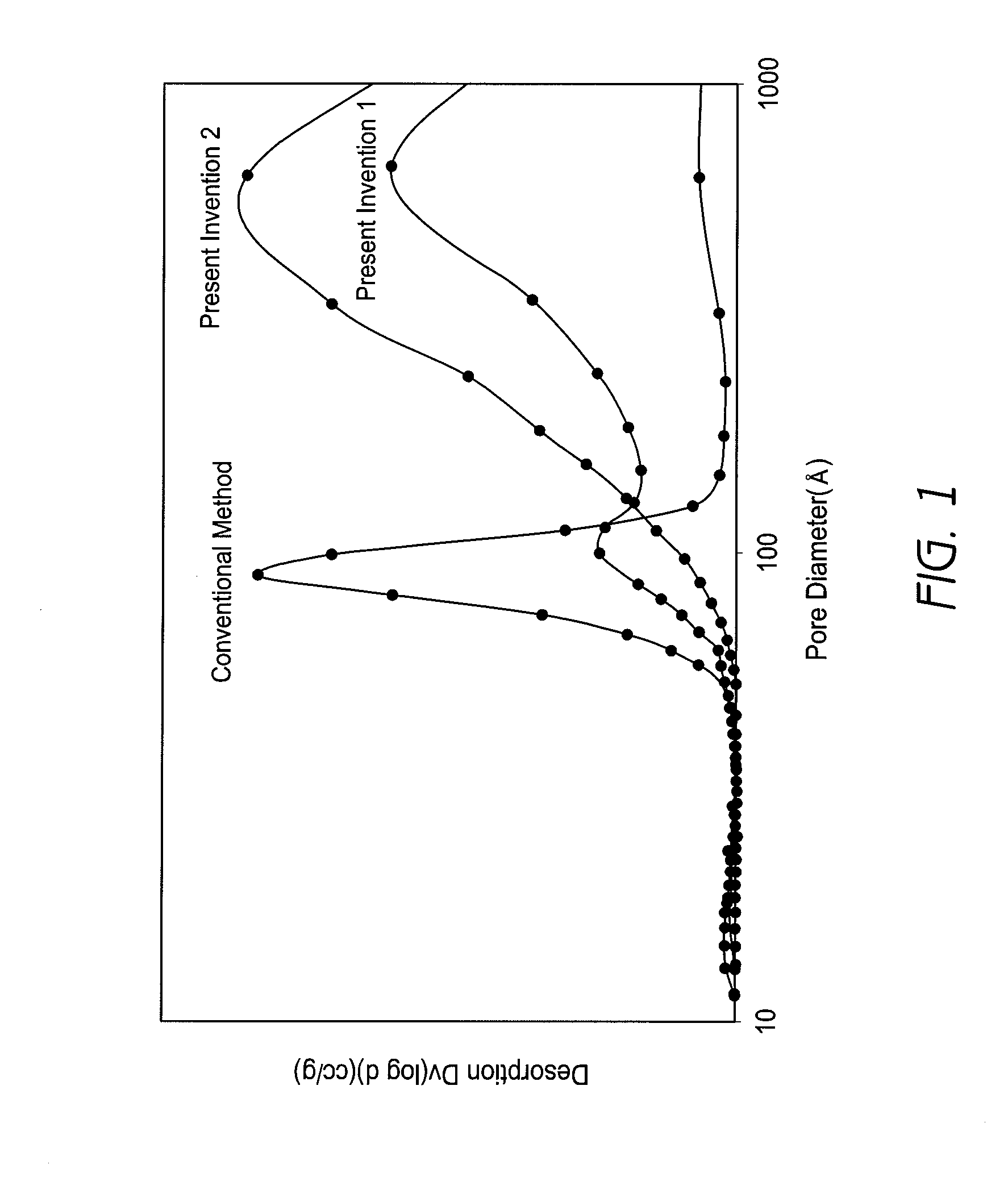Zirconia porous body and manufacturing method thereof
a zirconia and porous body technology, applied in the direction of catalyst activation/preparation, metal/metal-oxide/metal-hydroxide catalysts, chemical/physical processes, etc., can solve the problem of difficult to obtain adequate properties for various uses such as catalysts, unsatisfactory thermal stability at high temperatures (about 1000° c. ), and achieve excellent effects. the effect of improving the specific surface area and reducing the specific surface area
- Summary
- Abstract
- Description
- Claims
- Application Information
AI Technical Summary
Benefits of technology
Problems solved by technology
Method used
Image
Examples
example 1
[0101]1) 94 g of a 25% sodium sulfate solution was heated to 65° C., 250 g of a 16% (by ZrO2 conversion) zirconium oxychloride solution which had been previously heated to 75° C. was added thereto, hydrochloric acid was added to achieve a free acid concentration of 1.5 N and this was maintained for 0.5 hours to produce basic zirconium sulfate (low-temperature reaction liquid).
[0102]2) 141 g of a 25% sodium sulfate solution was heated to 85° C., 375 g of a 16% (by ZrO2 conversion) zirconium oxychloride solution which had been previously heated to 85° C. was added thereto, hydrochloric acid was added to achieve a free acid concentration of 1.5 N and this was maintained for 0.5 hours to produce basic zirconium sulfate (high-temperature reaction liquid).
[0103]3) The aforementioned low-temperature reaction liquid and high-temperature reaction liquid were mixed, heated to 95° C. and maintained for 0.5 hours to age them.
[0104]4) Next, the aged solution was cooled to room temperature and 12...
example 2
[0112]1) 237 g of a 25% sodium sulfate solution was heated to 85° C. and 625 g of a 16% (by ZrO2 conversion) zirconium oxychloride solution which had been previously heated to 85° C. was added thereto. The addition speed of the aforementioned zirconium oxychloride solution here was adjusted so that the production speed of basic zirconium sulfate as converted to zirconium oxide would be about 12 g / minute / L, or about ⅕ the normal speed. Next, hydrochloric acid was added to achieved a free acid concentration of 1.5 N, and this was maintained for 0.5 hours to produce basic zirconium sulfate.
[0113]2) The aforementioned reaction liquid was first heated to 95° C. and then maintained for 0.5 hours to age it.
[0114]3) Next, the aged solution was cooled to room temperature and 125 g of a 20% (CeO2 conversion) cerium nitrate solution was added to and mixed uniformly.
[0115]4) 25% sodium hydroxide was added to the resulting mixed solution to adjust to pH to 13 or more and produce a hydroxide prec...
example 3
[0130]A baked product was manufactured as in Example 1 except that step 4) in Example 1 was replaced by the following. The aged solution was cooled to room temperature, and a 15% titanium tetrachloride solution was added so as to achieve a titanium oxide (TiO2) content of 30% by weight of the final product (baked product), and mixed uniformly.
[0131]The material properties of the resulting baked product were measured as in Example 1. The results are shown in Table 1. The composition (% by weight) of the resulting baked product is shown in Table 1, and the material property values in Tables 2 and 3. The pore distribution of a product baked at 1000° C. was measured with roughly the same results as those shown under “Present Invention 1” in FIG. 1.
PUM
| Property | Measurement | Unit |
|---|---|---|
| pore diameters | aaaaa | aaaaa |
| pore diameters | aaaaa | aaaaa |
| diameter | aaaaa | aaaaa |
Abstract
Description
Claims
Application Information
 Login to View More
Login to View More - R&D
- Intellectual Property
- Life Sciences
- Materials
- Tech Scout
- Unparalleled Data Quality
- Higher Quality Content
- 60% Fewer Hallucinations
Browse by: Latest US Patents, China's latest patents, Technical Efficacy Thesaurus, Application Domain, Technology Topic, Popular Technical Reports.
© 2025 PatSnap. All rights reserved.Legal|Privacy policy|Modern Slavery Act Transparency Statement|Sitemap|About US| Contact US: help@patsnap.com

